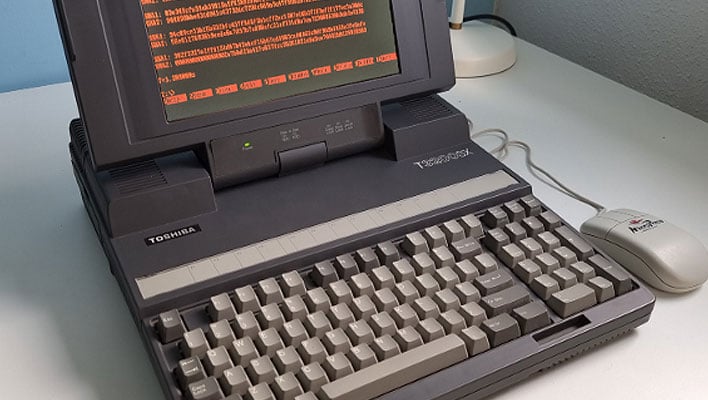Even A 16MHz Laptop From 1989 Can Mine Bitcoin But It Takes 584M Years To Earn $1

If you even owned a laptop from over 30 years ago, it's probably long-since been retired. Laptops did actually exist in the 1980s, though, and while mainly (not solely) built for word processing chores, an owner of a Toshiba T3200SX laptop from 1989 held onto his all these years and has put it to work mining Bitcoin. That's right, you can mine cryptocurrency on a PC from an era when a gallon of gasoline ran 97 cents.
Incidentally, it would take the Toshiba laptop around 584 million years to make $1 mining Bitcoin, based on current values and mining performance, etc. That's nonsense, of course—if the human race (or even planet Earth) is still around by then, nothing will be as it is now, including the value of a buck. But that estimate gives you an idea of how futile it is to mine cryptocurrency on ancient hardware. So why do it?
"Many devices can be used for Bitcoin mining, from ASIC or GPU cards to the Raspberry Pi. Why not try something really exotic? Like a 32-year-old laptop? Why? Because we can," Dmitrii Eliuseev explained in a Medium post.
Eliuseev is a Python and IoT developer, and also fancies himself a science and ham radio enthusiast, according to his profile page. He goes on to explain that "the best way to study any technology is to try it," even when the project itself isn't a practical one.
"I think readers can already guess that Bitcoin mining on a 30-year-old PC will not make you rich. But it is a nice try to understand how it works 'under the hood' and also to compare how the computer’s performance grew up during this time," Eliuseev points out.
While ancient by today's standards, that laptop would have set a buyer back $6,299 in 1989, which when factoring in inflation is equivalent to nearly $14,000 now. And what did that get you back then? A speedy 16MH 386SX processor.
I never owned a laptop from that era, but can tell you from personal experience that going from a 286 to a 386 on the desktop was a big upgrade. Even more so when the 486DX2 came became available, screaming at 66MHz. Beyond the hardware, though, the challenge in getting a PC from that era to mine Bitcoin also lies in the software. Since there are no MS-DOS programs to mine Bitcoin, Eliuseev made his own.
"The key component of the calculation is the SHA256 algorithm. I tried several C implementations, but some of them were not working properly on the 16-bit platform—the size of the variables on 16 and 32-bit C-compilers are different, and some bit-based arithmetic in the code can be broken. Finally, I’ve created my own code," he explains.
It worked, both on the Toshiba T3200SX and also on a T1100 Plus with a 7.1MHz 8086 CPU inside. Kudos to Eliuseev on the neat mining experiment, and for making his code available on GitHub.
Images courtesy of Dmitrii Eliuseev (via Medium)


